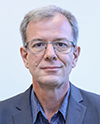The lockdown imposed by the COVID-19 situation challenged once more educators from school to university to rethink their mission while technology stepped into the breach stronger than ever. But is technology compatible with long-term learning ? What is the place of emotion in digital learning ? These are some of the questions answered in this older but so interesting interview of Prof. Rolf Gruetter, Full Professor at the EPFL, initially published in the NCCR Chemical Biology newsletter in July 2016.
Do you identify learning practices of digital native students that witness a gap between them and an institution created before the era of new technologies?
New technologies are double-edged. The perception of our past, remembering how we were as students, is not always accurate. I think that basically nowadays students are not different than what we were: one or two generations is too short to cause any biological changes. Students are still curious and competitive, which is in the human nature, and they are good. However, several external factors have changed. Firstly, social status and peer pressure play a big role, which can lead to significant gender differences. Secondly, there are nowadays more portable distractions whereas in the past the physical separation between activities was bigger as things were at different places. At last, taking notes, or the ability to do so, has diminished. Strikingly, “good” students are more able than the other ones to separate work from distraction and they do take notes. For a student to succeed it is very important to be able to directly start with a good study method, be organized and know where to get the information needed, be constantly hard working as the pace is intense. Life experience leading to maturity is also an important factor.
Numerous IT tools have emerged that revolutionize the way we learn. Do you think that these new technologies enhance long-term learning?
What makes someone remember something? There are three ways: a strong emotion, a relation (with a topic or a teacher) and repetition. A good teacher has to convey emotion, be inspiring and enthusiastic. But also demanding and, if needed, selective (giving insufficient mark when the student is not good).
I have my courses filmed since 2006, and they are freely accessible on the Internet. Despite of it, many of the students come to the courses as well! Filmed courses or MOOCs represent to me great additional resources. Look at the famous physics courses from Walter Lewin (MIT), available on YouTube, it has received many thousands views. However, it is clear that only the well organized students do fully benefit. “Liking” is not “learning”. Virtual “reality” tools, e.g. Labster, can be a support, but the real world is far more motivating, and thus will have a longer lasting impact.
What key issues do you see in integrating IT tools in education today?
The focus of a teacher should be local (his own students), but should be accessible for all, which is especially useful for those in regions with no or poor teaching. MOOC’s and films are fine as long as the teacher is comfortable on stage. Interactions and contact with students are important, especially on a one-to-one basis or in small numbers. A small room is better than a big auditorium. I am asking: how will certification be regulated and verified with students from all over the globe?
What is your vision of the future of learning?
My vision is to combine the best of both worlds! On the one hand, good old live teaching conveying emotions, sparkling the mind. On the other hand, courses recorded as simple movies or MOOC’s to be available to all as a virtual support. Also, films and MOOC’s might be more cost effective and could be a way to attract students.
 Rolf Gruetter concluded his thesis in 1990 at the ETH Zürich, with Prof. K. Wüthrich as referent. After a stay at the Department of Molecular Biophysics and Biochemistry of the Yale University, he became in 2002 Associate Professor at University of Minnesota. In 2006, he became Full Professor at the EPFL, heading the Laboratory for Functional and Metabolic Imaging. He is the Director of the Centre d’Imagerie BioMédicale of the UNIL, UNIGE, HUG, CHUV and EPFL. He received in 2011 the Teaching Award of the Life Science Section.
Rolf Gruetter concluded his thesis in 1990 at the ETH Zürich, with Prof. K. Wüthrich as referent. After a stay at the Department of Molecular Biophysics and Biochemistry of the Yale University, he became in 2002 Associate Professor at University of Minnesota. In 2006, he became Full Professor at the EPFL, heading the Laboratory for Functional and Metabolic Imaging. He is the Director of the Centre d’Imagerie BioMédicale of the UNIL, UNIGE, HUG, CHUV and EPFL. He received in 2011 the Teaching Award of the Life Science Section.
Cover photo by Marvin Meyer on Unsplash

Leave a comment
The editors reserve the right not to publish comments or to abridge them.